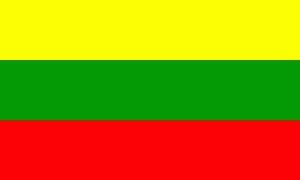
Lithuania
Quick reference
General issues: Republic 1918-1940, Soviet socialist republic within the Soviet Union 1940, Republic 1990-Present
Country name on general issues: Lietuvos pašta(s), Lietuvos pašto ženklas, Lietuva
Special issues:
- Occupation issues WWI: Oberbefehlshaber Ost 1915-1918
- West Russian Army 1919
- Local issues Raseiniai 1919, Grodno 1919, Telšiai 1920
- Local issue Varviškė 1923
- Memel
- French administration 1920-1923
- Lithuanian administration 1923-1925
- Local issue 1939
- Occupation issues WWII
- Lithuania 1941
- Vilnius 1941
- Local issues 1941 Alsėdžiai, Panevėžys, Raseiniai, Rokiškis, Telšiai, Ukmergė, Zarasai
- Reichskommissariat Ostland 1941-1944
Related issues:
- Central Lithuania 1920-1922
Currency: 1 Auksinas = 100 Skatikai 1918-1922, 1 Litas = 100 Centai 1922-1940, 1 Ruble = 100 Kopeks 1990-1992, 1 Tolona = 100 Kopeks 1992-1993, 1 Lats = 100 Santimi 1993-2015, 1 Euro = 100 Eurocent 2015-Present
Population: 2 029 000 in 1923, 2 854 000 in 2016
Political history Lithuania
Early history and WWI
Lithuania is one of the Baltic states located in northern Europe – the Lithuanians are a Baltic people. The grand duchy of Lithuania was first established as a political entity in 1253. The grand duchy expanded and was at the height of its power in the 15th century. Lithuania was ruled in personal union with Poland from the 14th century and, with Poland, formed the Polish-Lithuanian Commonwealth in the 16th century. In the late 18th century, Lithuania became part of the Russian empire. Within the Russian empire, Lithuania was divided and administered as part of three governates.[1]In imperial Russia, a governate was the administrative level just below the national level. Lithuania, in the early 20th century, was part of the governates of Kovno, Suwałki and Vilnius. During WWI, Lithuania was occupied by Germany in 1915. Lithuania was brought under military administration as part of the area administered by the Oberbefehlshaber Ost.[2]The Oberbefehlshaber Ost was the supreme commander of the German forces on the Russian front during WWI. For a map of the area controlled by the Oberbefehlshaber Ost, please refer to the map of Germany 1914-1938.
Towards independence
Lithuanian nationalism developed in the 19th century. In Russia, the 1917 Russian Revolution led to the Russian Civil War and a range of ethnic minorities proclaiming independent states across the empire. Lithuania proclaimed independence as the republic of Lithuania in February 1918, while still under German occupation. Germany recognized Lithuanian independence in March 1918, as it had an interest in forming buffer states under German control between Germany and the Russian empire. After the German capitulation, that ended WWI in November 1918, the first Lithuanian government was formed.
Lithuanian Wars of Independence
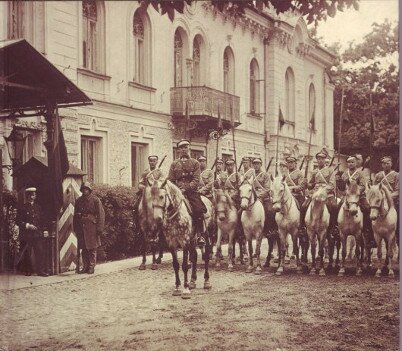
1919 – Lithuanian cavalry in front of the presidential palace.
Following the German capitulation, Lithuania was involved in what are called the Lithuanian Wars of Independence. Lithuania faced three major opponents:
- The fight for Lithuanian independence was intertwined with the Russian Civil War that ensued after the Bolsheviks took power in Russia in October 1917 . The Russian Civil War was fought between the Bolsheviks – the Reds – and those that opposed the Bolsheviks – the Whites. In November 1918, Red Russian forces invaded Lithuania, and, in February 1919, formed the Lithuanian socialist Soviet republic in opposition to the government of the Lithuanian Republic. In the course of 1919, Lithuanian forces, supported by German forces, successfully countered the Russian invasion and, by October 1919, the Red Russian forces were driven out of the country. In July 1920, Russia recognized Lithuanian independence by way of the Treaty of Moscow, signed in 1920.
- In July 1919, Lithuania was invaded from Latvia by the West Russian Army, led by Colonel Pavel Bermondt-Avalov. The West Russian Army was formed in Latvia and, nominally, fought under the flag of White Russia. In fact, the West Russian Army consisted largely of Germans and Baltic Germans[3]Germans had settled in the Baltics since the 12th century and gradually grown to be the elite in Baltic societies, particularly in Estonia and Latvia, but also in Lithuania. that aimed to establish a Baltic German state. The West Russian Army was defeated in December 1919 and subsequently dissolved.
- In 1920, Poland and Lithuania engaged in military conflict over two regions that were claimed by both nations and that had changed hands several times between Lithuanian, Polish and Red Russian forces in 1918 and 1919: the Suwałki region and the Vilnius region. Under international pressure, both conflicts ended in de facto borders being defined – de facto borders, that de jure were not recognized by Lithuania. Lithuania severed diplomatic relations with Poland until 1938. A closer look at each of the conflicts:
- The conflicting claims on the Suwałki region escalated into military conflict in August 1920. In October 1920, an armistice agreement – the Suwałki Agreement – was signed. The demarcation line, that was part of the agreement, came to serve as the de facto border in the region.
- The Vilnius region was, in 1920, in part controlled by Lithuania and in part by Poland – Vilnius being Lithuanian. In 1920, Poland, wanting to prevent a confrontation with the League of Nations, staged the mutiny of a division of the Polish army[4]The 1st Lithuanian-Belarusian Infantry Division, composed, mainly, of Lithuanian and Belorussian troops and led by Lucjan Żeligowski. that gained control of Vilnius in October 1920 – to establish the republic of Central Lithuania. In February 1922, the Central Lithuanian parliament voted for association with Poland. Poland obliged and annexed the region in April 1922. The League of Nations accepted the new situation and a demarcation line, set by the League of Nations, came to serve as the de facto border from March 1923. In the town of Varviškė – also known as Warwiszki, just outside Central Lithuania on the Lithuanian side of the border – the Polish population revolted. The revolt was soon crushed by Lithuanian forces.
Memel
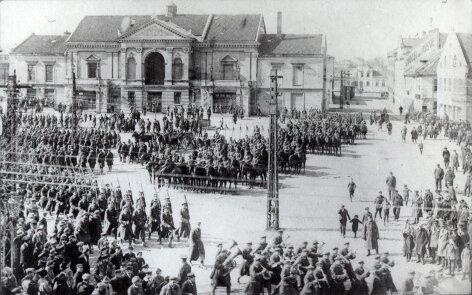
1923 – Lithuanian forces parade in Memel after international recognition of the annexation of Memel by Lithuania.
The Memel territory – Klaipėda in Lithuanian – was one of parts of the German empire that, at the end of WWI, was placed under international supervision to allow time for a decision about the future of the territory. On behalf of the Conference of Ambassadors,[5]The Conference of Ambassadors was an Allied organization which supervised the implementation of peace treaties and mediated in territorial disputes following WWI. The Conference acted as a de facto institution of the League of Nations. the French took over the administration of the territory in 1920. Lithuania had an interest in the Memel territory as the port of Memel would provide access to the Baltic Sea for Lithuania. Furthermore, Memel had a significant Lithuanian minority. In January 1923, Lithuania staged a rebellion in Memel, the rebels requesting to be united with Lithuania. Subsequently, Lithuania annexed Memel. The Conference of Ambassadors conditionally accepted Lithuania’s annexation in February 1923. The annexation was formalized through the Memel Convention, approved by the League of Nations in 1924. The Memel Convention took effect in 1925.
In the advent of WWII, Germany demanded the return of Memel to Germany in March 1939. To prevent war Lithuania chose to cede Memel. At the end of WWII, the region was occupied by the Soviet Union in 1945. Subsequently, Memel was annexed by the Soviet Union and awarded to Lithuania in 1948.
The interwar period and WWII
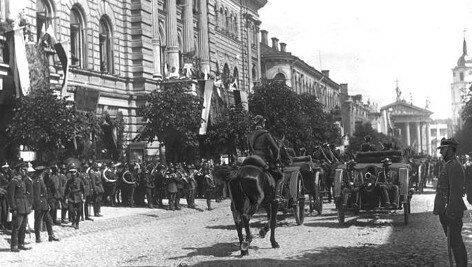
1939 – The incorporation of Vilnius into Lithuania.
Lithuania was, initially, governed as a parliamentary republic. In 1926, a coup d’etat brought Antanas Smetona to power, who, as an authoritarian ruler, would be in power in Lithuania until 1940.
In 1939, in the advent of WWII, Germany and Russia signed the Molotov-Ribbentrop Pact, defining their respective spheres of interest in eastern Europe. The Soviet Union, subsequently, enforced the Soviet–Lithuanian Mutual Assistance Pact on Lithuania, demanding that Soviet forces be stationed in Lithuania. As compensation, Lithuania was awarded part of the Vilnius region – including Vilnius.[6]The Soviet Union had, before imposing itself on Lithuania, occupied eastern Poland, thus gaining control on Vilnius. In June 1940, the Soviet Union proceeded to occupy Lithuania. The Lithuanian Soviet socialist republic was formed in July 1940 and was annexed into the Soviet Union in August 1940.
Soviet rule would last a year. In June 1941, Germany invaded the Soviet Union and, by the end of June 1941, Lithuania was occupied. Following German occupation, a Lithuanian provisional government was established in Kaunas, expecting the return to an independent Lithuania. This provisional government was suppressed by the German military administration in August 1941. After a period of military administration, Lithuania came under civil administration, in September 1941, as part of the ‘Reichskommissariat Ostland’.[7]The Reichskommissariat Osland included the Baltic states and parts of Poland and Belarus. For a map of the area administered by the Reichskommissariat Ostland, please refer to the map of Germany 1938-1945. As the tables turned in WWII, the Soviet Union drove back the German forces. Vilnius was regained by the Soviet Union in July 1944 and all of Lithuania by January 1945.
The Lithuanian Soviet Socialist Republic
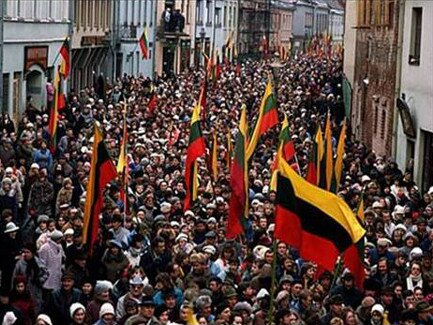
1990 – People taking to the streets to celebrate independence.
Reestablished as the Lithuanian Soviet socialist republic, Lithuania was now fully integrated into the Soviet Union. In 1944, the border was set as it had been defined in 1939, including Vilnius, and, in 1948, Memel was reincorporated into Lithuania. Resistance against Soviet rule was quenched by the early 1950’s and significant numbers of Lithuanians were deported. Private holdings were nationalized and collectivized. Although de jure an independent state with its own governmental institutions, de facto Lithuania was ruled from the Kremlin in Moscow. Just the same, Lithuania, in the Soviet era, developed into an ethnic homogeneous society. Many of the large Polish minority moved to Poland and while ethnic Russians moved into the country, they did so in much smaller numbers than in the neighboring Baltic states.
The 1980’s brought liberalization. The Supreme Soviet of the Lithuanian Soviet socialist republic took an increasingly independent stance vis-a-vis the Kremlin. New political parties were formed. In 1990, Lithuania proclaimed independence as the republic of Lithuania. Although the Soviet Union, initially, tried to turn the tide, after the break up of the Soviet Union, Lithuanian independence was recognized in 1991.
Modern day Lithuania
Since independence, Lithuania is, again, governed as parliamentary republic. While many of the former parts of the Soviet Union stayed closely affiliated with the Russian Federation in the Commonwealth of Independent States, Lithuania turned west – as did the other Baltic states. Lithuania joined NATO and the European Union in 2004.
Economically, Lithuania transformed from a planned economy into a free market economy, privatizing state holdings. The Lithuanian mixed economy – with services as the most important sector – is one a the fastest growing economies in Europe. Lithuania ranks as a Very High Development Country on the United Nations Index for Human Development. Lithuanians form the vast majority of the population at 84%. Ethnic Poles and Russians are a minority at 6% each.
Postal history Lithuania
WWI and the interwar period
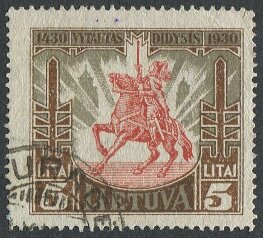
1930 – Issued in commemoration of Vytautas the Great. Vytautas ruled Lithuania in the 15th century and is a symbol of Lithuanian independence.
Lithuania, as part of the Russian empire, used Russian stamps. Russian stamps were, during the German occupation in WWI, superseded by the issues for the Oberbefehlshaber Ost – German stamps overprinted ‘Postgebiet Ob Ost'[8]Postal area Ob. Ost. . The republic of Lithuania issued its first stamps in December 1918. The first issues were of a very basic, provisional design. The first stamps of a professional design appeared in February 1919 – showing the coat of arms of the republic. Local issues appeared in Grodno, Raseiniai and Telšiai – Grodno at the time being in Lithuanian hands, later to become Polish.[9]The Raseiniai and Telšiai issues are listed in the Michel catalog, the Grodno issue is also listed in Scott and Yvert & Tellier. The republic of Lithuania issued stamps until May 1940. The Lithuanian Soviet Socialist Republic issued one set of stamps in August 1940, after annexation by the Soviet Union – Lithuanian stamps overprinted ‘LTSR – 1940 VII 21’.[10]‘LTSR’ is the abbreviation of Lietuvos Tarybu Socialistine Respublika or Lithuanian Soviet Socialist Republic. Lithuanian stamps were superseded by the issues of the Soviet Union.
The Lithuanian Wars of Independence
Some of the factions in the Wars of Independence issued stamps as follows:
- The West Russian Army issued several sets of overprinted Russian stamps that appeared in October and November 1919. One set of definitives was prepared, but was not released before the demise of the West Russian Army.
- The republic of Central Lithuania issued stamps between 1920 and 1922 – these are discussed in more detail in a separate profile.
- A provisional issue appeared in March 1923 in the town of Varviškė – Warwiski in Polish. The issue consists of overprinted Polish stamps that were used to transfer mail to the nearest Polish post office – the overprint read ‘Samorzad Warwiski’ for ‘Autonomous Warwiszki’.[11]Listed in the Michel and Yvert & Tellier catalogs under Poland.
Memel
The French administration of Memel issued stamps from August 1920. The first set were German stamps overprinted ‘Memelgebiet'[12]‘Memel Territory’ . All subsequent issues were French stamps overprinted ‘Memel’ with a new denomination in the German currency. After the annexation of Memel by Lithuania, the first provisionals using Lithuanian stamps were issued in February 1923. The overprint read ‘Klaipėda – Memel’ and a new denomination in the German currency. In March 1923, the first definitives inscribed ‘Klaipėda – Memel’ followed. In April 1923, the first issues appeared in the Lithuanian currency. From August 1923, Lithuanian stamps were brought into circulation, concurrent with the issues for Memel. The issues for Memel were valid until August 1925.
In 1939, as Germany annexed Memel, a local issue appeared. Lithuanian stamps were overprinted ‘Memelland ist frei’ for ‘Memelland is free’ – an overprint similar to those found on the local issues that appeared in Sudetenland that was annexed by Germany, also, in 1939.[13]Listed in the Michel catalog.
WWII
During the German occupation in WWII, German stamps without overprint were valid for use in Lithuania. An issue for specific use in Lithuania appeared in June 1941. The stamps were issued by the Lithuanian postal services – Russian stamps overprinted ‘Nepriklausoma Lietuva – 1941-VI-23’ which translates to ‘Independent Lithuania’, reflecting the notion Lithuanians had that the German invasion might bring independence after Soviet occupation.[14]Listed in the Michel and Yvert & Tellier catalogs A further set was issued in July 1941 for the Vilnius region – again overprinted Russian stamps, the overprint now reading ‘Vilnius’.[15]Listed in the Michel and Yvert & Tellier catalogs. Resources used do not indicate just exactly what constitutes the Vilnius region. However, in their listings, both Michel and Yvert & Tellier set the Vilnius issues apart from the local issues. Local issues appeared in a number of towns – all overprinted Russian stamps.[16]Listed in the Michel catalog From November 1941, the stamps issued by the Reichskommissariat Ostland were brought into circulation – German stamps overprinted ‘Ostland’. German stamps without overprint remained valid for use throughout the German occupation, although they were only available from post offices until the introduction of the issues of the Reichskommissariat ‘Ostland’. When the Soviet Union recaptured Lithuania in 1944-1945, Soviet stamps came back into use.
Independent Lithuania
After the proclamation of independence, Lithuania issued its first stamps in October 1990. These, and subsequent issues until August 1991, were not brought into circulation until September 1991, when the Soviet Union recognized Lithuanian independence. Soviet stamps remained valid until the end of December 1991. Independent Lithuania issues stamps, mainly, with themes of national interest.
Album pages
← Previous page: LatviaNext page: North Ingria/North Ingermanland →

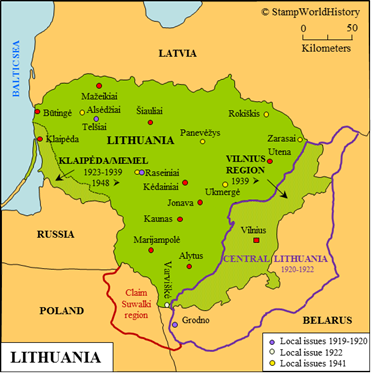
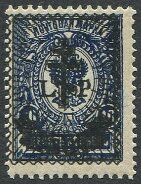
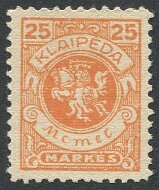
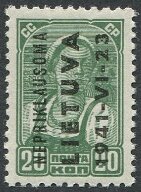
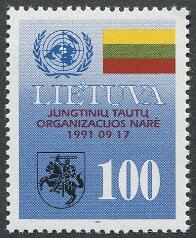
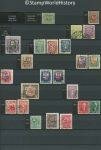

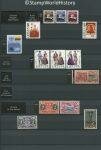
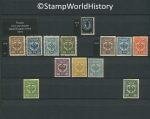
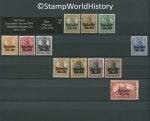
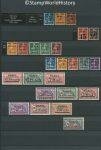


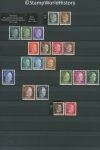
Gerben, thank you for nice article about Lithuania and his stamps history. Perhaps the following my remarks will be useful for you.
1. Currency 1918-1922. Not „skatinai“, but „skatikai“.
2. Country names on the stamps. „Lietuvos paštas“, „Lietuvos pašto ženklas“ (=Lithuanian post stamp) and other names also were used in 1919-1921.
3. Vilno. Must be Vilnius (Lithuanian name). Wilno is Polish spelling, Vilno – unknown spelling.
4. Map. Not Rosiškis, but Rokiškis.
5. Modern day Lithuania. While other parts of Soviet Union …. It is not correct, Latvia and Estonia also turned west. It is better to say: while the most of other former soviet republics ….
6. Latvia, Estonia. The same remark.
7. WWII. When the Soviet Union recaptured Latvia …..Latvia or Lithuania?
Best regards Gedi
Gedi
Thank you for being such an attentive reader. Your comments are – as before – very much appreciated. I updated the profile accordingly. Vilno? Must have had a black out….